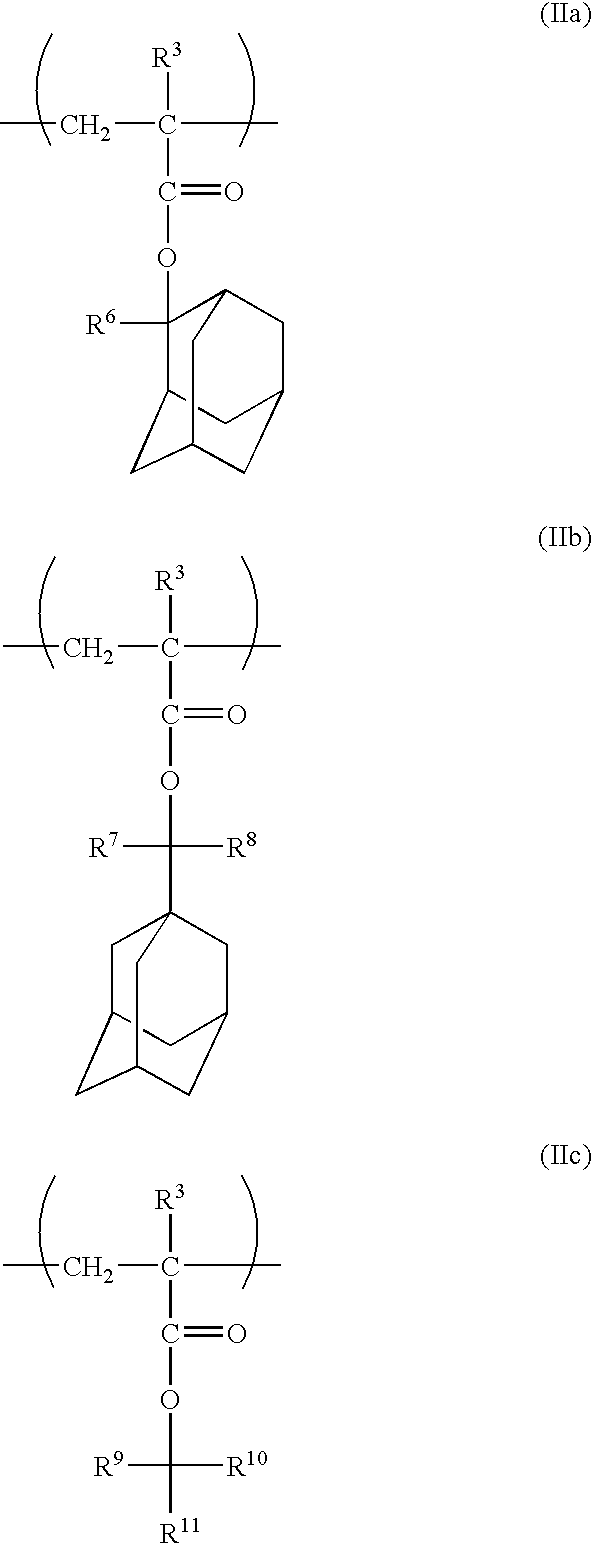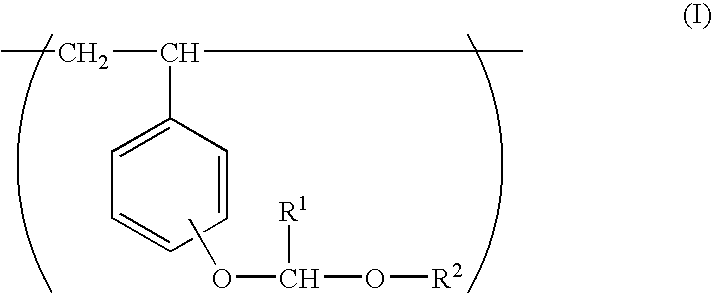Positive resist composition
a composition and resist technology, applied in the field of resist composition, can solve the problems of increasing the irregularity of processing dimension, deteriorating resolution, and roughness of line edges of patterns, and achieve the effect of improving pattern profile and resist composition
- Summary
- Abstract
- Description
- Claims
- Application Information
AI Technical Summary
Benefits of technology
Problems solved by technology
Method used
Image
Examples
synthesis example 1
Synthesis of Partially Etherified poly(p-hydroxystyrene) with 1-ethoxyethyl Group
[0164]Into a 1 liter eggplant type flask was charged 40 g of poly(p-hydroxystyrene) [Weight-average molecular weight 18000, degree of dispersion: 1.1] (333 mmol calculated using molecular weight of p-hydroxystyrene structural unit) and 47 mg (0.25 mmol) of p-toluenesulfonic acid monohydrate, and these were dissolved in 720 g of propylene glycol monomethyl ether acetate. This solution was subjected to pressure-reduced distillation under conditions of a temperature of 60° C. and a pressure of 10 Torr (1333 Pa) or less, to cause azeotropic dehydration. The weight of the solution after distillation was 337 g. This solution was transferred into a nitrogen-purged 500 ml four-necked flask, into this was dropped 12.0 g (166 mmol) of ethyl vinyl ether, then, these were reacted at 25° C. for 5 hours. To the reaction solution was added 62.3 g of propylene glycol monomethyl ether acetate and 320 g of methyl isobuty...
synthesis example 2
Synthesis of Partially Etherified poly(p-hydroxystyrene) with 1-ethoxyethyl Group
[0165]Reaction, post treatment and analysis were conducted in the same Hanner as in Synthesis Example 1 except that the amount of ethyl vinyl ether was changed to 10 g (138 mmol) to obtain solution of partially etherified poly(p-hydroxystyrene) with 1-ethoxyethyl group. 30% of hydroxyl group in poly(p-hydroxystyrene) was etherified 1-ethoxyethyl group. This polymer is called resin A2.
synthesis example 3
Synthesis of Partially Esterified poly(p-bydroxystyrene) with 1-pivaloyl Group
[0166]20 parts of poly(p-hydroxystyrene) [“PHS-15E01” manufactured by Try Quest K.K., weight-average molecular weight: 15000, degree of dispersion: 2.0] (0.17 mol calculated using molecular weight of p-hydroxystyrene structural unit) and 200 parts of acetone were charged and stirred for dissolution thereof, then, to this was added 6.3 parts (0.06 mol) of triethylamine and the mixture was heated at 35° C. Into this resin solution was dropped 5.8 parts of pivaloyl chloride (0.047 mol, 0.29 equivalent based on hydroxyl group of poly(p-hydroxystyrene)) over about 10 minutes. The mixture was stirred at 35° C. for 1.5 hours, then, 300 parts of methyl isobutyl ketone was added, and the mixture was washed with a 0.5% oxalic acid aqueous solution three times. The resulted organic layer was further washed with ion-exchanged water to cause liquid separation, and this operation was repeated five times. From this organ...
PUM
| Property | Measurement | Unit |
|---|---|---|
| temperature | aaaaa | aaaaa |
| pressure | aaaaa | aaaaa |
| temperature | aaaaa | aaaaa |
Abstract
Description
Claims
Application Information
 Login to View More
Login to View More - R&D
- Intellectual Property
- Life Sciences
- Materials
- Tech Scout
- Unparalleled Data Quality
- Higher Quality Content
- 60% Fewer Hallucinations
Browse by: Latest US Patents, China's latest patents, Technical Efficacy Thesaurus, Application Domain, Technology Topic, Popular Technical Reports.
© 2025 PatSnap. All rights reserved.Legal|Privacy policy|Modern Slavery Act Transparency Statement|Sitemap|About US| Contact US: help@patsnap.com



